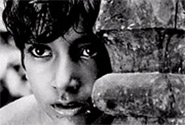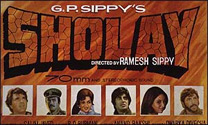|
|

|
|

The Indian film industry is the oldest and the largest in the world with over 1200 movies released annually. The majority of films are made in the South Indian languages mostly Telugu, Tamil and Malayalam, but Hindi films take the largest box office share. Mumbai (Bombay), Chennai (Madras), Kolkata (Calcutta), Bangalore and Hyderabad are the main film production centers. With more than12000 cinema halls, the Indian film industry turn out more than 1000 films a year to hugely appreciative audiences around the world.
 The history of Indian Cinema can be traced back to 1896 when the famous Lumiere
Brothers' of France demonstrated six soundless short films in Bombay. By 1899,
Harishchandra Bhatvadekar made India's first short film.
This was one of the major milestone in Indian Cinema. Throughout the first two decades, the trend continued with filmmakers.
The history of Indian Cinema can be traced back to 1896 when the famous Lumiere
Brothers' of France demonstrated six soundless short films in Bombay. By 1899,
Harishchandra Bhatvadekar made India's first short film.
This was one of the major milestone in Indian Cinema. Throughout the first two decades, the trend continued with filmmakers.
Dhundiraj Govind Phalke who was generally known as Dada Saheb Phalke produced India's first full length silent film, 'Raja Harishchandra', in 1913. He laid the foundation for the beginning of a regular feature film industry in India. By 1920 there was a regular industry bringing out films starting with 27 per year and reaching 207 films in 1931. Many new companies and film makers came up during that period.
The 1930s saw sweeping changes to the industry, technically and stylistically. The most remarkable thing that happened in Indian film industry was in 1931, when India's first talkie, 'Alam Ara', directed by Ardeshir Irani was released. Dubbed into Hindi and Urdu, the film was a smash hit and a new revolution began in the Indian film industry. It's phenomenal success all over India lead to other 'Talking, Singing and Dancing' productions to be hurriedly put into production. At the same time, it marked the beginning of the Talkie era in South Indian film industries also. The first talkie films in Bengali (Jumai Shasthi), Telugu (Bhakta Prahlad) and Tamil (Kalidass) were released in the same year 1931.
The 30's is recognized as the decade of social protest in the history of India films. In the 30's three major film centres developed which were based in Bombay (Mumbai), Calcutta (Kolkata) and Madras (Chennai). Of these centres, Bombay was known for the making of films geared for national distribution, while Madras and Calcutta were known for their regional films.
From the 1940's to the late 1950's, the films with their concentration on vibrant song and dance, were for many, the most memorable in Indian film history. The 1940s and 1950s also saw the emergence of the 'playback singing', the off-camera voice that performs the songs that the actors and actresses subsequently mime to. Lata Mangeshkar, her sister Asha Bhonsle, Muhammed Rafi, Kishore Kumar etc are the singers who dominated the Hindi film industry. Now music became an important ingredient in Indian cinema.
 The 50's was a unique time in Indian cinema, blessed with talented directors and artistes who could stamp their individuality in their work.. The big turning point came in 1953 with the arrival of
Bengali director Satyajit Ray and his classic
'Pather Panchali'. International recognition came to
it with the Cannes award for the best human document, followed by foreign and national awards.
The 50's was a unique time in Indian cinema, blessed with talented directors and artistes who could stamp their individuality in their work.. The big turning point came in 1953 with the arrival of
Bengali director Satyajit Ray and his classic
'Pather Panchali'. International recognition came to
it with the Cannes award for the best human document, followed by foreign and national awards.
Apart from Ray, Mrinal Sen, Ritwik Ghatak and others made internationally acclaimed movies. They are known as the founding fathers of the new cinema in India. While, Satyajit Ray, Mrinal Sen, Aravindan, Ritwik Ghatak, Rituparna Ghosh were pioneering the nation's art cinema, around the same time India also had a kind of popular cinema with social themes - again, particularly in Hindi - made by commercial film-makers like Bimal Roy, Raj Kapoor, Mehboob Khan, Guru Dutt etc. Many of these films no doubt broke records at the box office. eg. Bimal Roy's 'Do Bigha Zamin', Mehboob Khan's 'Mother India', Raj Kapoor's 'Shree 420' and 'Awara', Guru Dutt's 'Pyasa' etc.
 Another
factor that encouraged truly good Indian cinema was the establishment of National
Film Awards, the Film Finance Corporations, the National Film Archives of India
and the Film and Television Institute of India. The first International Film
Festival in 1952 held at Bombay, Chennai, Delhi and Calcutta
had great impact on Indian Cinema. Introduction to international films left
a deep impact on Indian film makers.
Another
factor that encouraged truly good Indian cinema was the establishment of National
Film Awards, the Film Finance Corporations, the National Film Archives of India
and the Film and Television Institute of India. The first International Film
Festival in 1952 held at Bombay, Chennai, Delhi and Calcutta
had great impact on Indian Cinema. Introduction to international films left
a deep impact on Indian film makers.
In the sixties and seventies, big budget films as well as off-beat films increased. The popular Hindi films of this period were: Kamal Amrohi's Pakeeza, Raj Kapoor's Bobby, Ramesh Sippy's Sholay, Kabhi Kabhi, Amar Akbar Anthony, Hum Kisise Kum Nahin, and Muqaddar ka Sikandar.